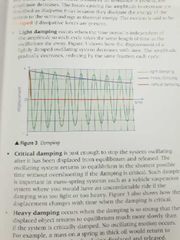![]()
![]()
![]()
Use LEFT and RIGHT arrow keys to navigate between flashcards;
Use UP and DOWN arrow keys to flip the card;
H to show hint;
A reads text to speech;
21 Cards in this Set
- Front
- Back
|
What is the equation that relates energy to mass? |
Einstein's equation of relativity E=mc². E= energy. M= mass. C= speed of light. |
|
|
What is omega ( weird w) equal to? |
Angular speed. = 2πf or 2π÷t. |
|
|
If oscillations have a constant amplitude and no frictional forces are present, what are they described as? |
Free vibrations. |
|
|
What is the equation for phase difference in radians? |
Phase difference= 2π∆t÷T. Where ∆t is the difference in time and T is the time period. |
|
|
What determines the frequency of oscillations on a loaded spring? |
1. Adding extra mass. Increases the inertia of the system so it has a lower frequency. 2. Using weaker springs. Reduces the restoring force so it oscillates with a lower frequency. |
|
|
What remains constant for a pendulum oscillating freely? |
Amplitude, frequency, time period and total energy of the system.( Ek+Ep). |
|
|
What are the three types of dampening? |

Light damping - occurs when the time period is independent of the amplitude so each cycle takes the same amount of time. Amplitude gradually decreases. Heavy damping - no oscillations occur the system gradually returns to equilibrium. Returns to equilibrium faster than light damping but slower than critical damping. Critical damping - Stops the system oscillating after it has been released. It gets back to equilibrium in the quickest possible time. |
|
|
What are forced vibrations? |
Applying a periodic force to something that is oscillating. |
|
|
What phase difference is required between the applied force and the oscillating force in order for resonance to occur? |
π÷2. |
|
|
What is a resonant frequency? |
The frequency at which an object oscillates with maximum amplitude. |
|
|
For an oscillating system with little or no damping, at resonance, the applied frequency of the applied periodic force is equal to? |
The applied frequency of the periodic force = the natural frequency of the system. |
|
|
What is the ideal gas equation? |
pV=nRT. p=Pressure. V=volume. n=number of moles. R=Gas constant. T=temperature. |
|
|
What is Faraday's law? |
The induced e.m.f. is directly proportional to the rate of change of flux linkage. |
|
|
What is lenz's law? |
The induced e.m.f. is always in such a direction as to oppose the change that caused it. |
|
|
what are the most stable nuclei? |
Nuclei's with an atomic mass between 50 and 60. the higher the binding energy per nucleon the more stable the nuclide is. |
|
|
what are the most stable nuclei? |
Nuclei's with an atomic mass between 50 and 60. the higher the binding energy per nucleon the more stable the nuclide is. |
|
|
what is nuclear fission? |
The process in which a large unstable nucleus splits into two smaller fragment nucleus that are more stable than the original. |
|
|
what is nuclear fusion? |
The process of making small nuclei fuse together to form a larger nucleus. the stability of the nucleus goes up provided the binding energy per nucleon also increases. |
|
|
what are the stages of nuclear fission? |
1. A uranium nucleus is bombarded with slow moving fission neutrons. 2. The uranium nucleus splits into two daughter nuclei. It also releases other neutrons. 3. The other neutrons released are slowed down by the moderator and can cause other uranium necleus's to undergo fission. this causes a chain reaction. |
|
|
What is the purpose of a moderator and control rods in a nuclear reactor? |
A moderator slows down the emitted neutrons so they can be absorbed by the uranium nucleus and cause fission. Is normally pressurised water. Control rods slow down the reaction by absorbing some of the emitted neutrons. |
|
|
What is Kepler's 3rd law? |
r³=kT². for any planet the cube of the radius of orbit is directly proportional to the square of its time period. |

